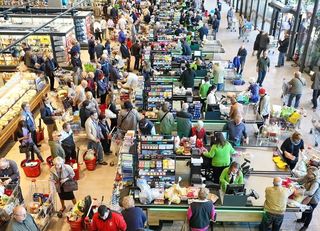Anxiety
How Panic Buying Affects Our Personal Finances
For many, it will lead to overspending, credit card debt, and greater anxiety.
Posted March 16, 2020 Reviewed by Ekua Hagan
Delish: "What was everyone's weirdest panic purchase?"
gce_and_me: Chef Boyardee! And I haven't eaten that since the early 90s!!?! I'm sure it will live in my pantry until the zombie apocalypse. – Instagram
Over the past week, panic buying of groceries has become widespread throughout the United States. It began with toilet paper, hand sanitizers, and bottled water. Then, as concerns about the spread of coronavirus grew along with the number of Americans infected with the virus, panic buying became more broad-based. Everything from milk and floor cleaner to gluten-free cereal and canned meat has been fair game during the nationwide panic buying spree.
There is a range of psychological reasons for panic buying, which I have considered separately. In this post, I want to look at the impact that panic buying has on shoppers' personal finances. To do this, first, let's consider three relevant characteristics of panic buying.
1. Panic buying is unplanned.
By its very nature, a panic buying spree comes out of the blue. With the coronavirus, as news about its spread in China circulated for weeks, there was little impact on Americans' shopping behavior. As it spread to Italy and other countries, there were ripples of concern. Then suddenly, it seemed as if everyone was rushing to the store to stock up their pantries and refrigerators at the same time. Under such circumstances, very few people could time their panic buying sprees with their regularly scheduled grocery shopping trips or buy the items they really needed.
2. Panic buyers end up with large shopping baskets.
Watch a video or look at photographs of shoppers coming out of stores during panic buying events. Invariably, you will see their carts are full. For many shoppers, especially during the current coronavirus spread, panic buying is a way to build up a store of food and essentials for use in case there is a lengthy quarantine or lockdown.
Marketing research company Nielsen refers to this consumer behavior as "pantry preparation" in which consumers engage in "pantry stockpiling of shelf-stable foods and a broader assortment of health-safety products" accompanied by a "spike of in-store visits" and "growing basket sizes." Instead of buying a package of toilet paper or a box of breakfast cereal, people buy a case of these items. The typical panic-buying shopping spree involves a significantly larger expenditure than a regular grocery shopping trip.
3. Panicked shoppers purchase indiscriminately based on availability rather than preference or price.
During a panic buying spree, shoppers have less power to decide or act as they would like. Grocery stores are crowded, often with long lines just to get in. Shelves are empty or quickly become so even as store employees scramble to restock them. Other shoppers appear fearful and rushed, randomly scooping up large quantities of various things.
Such an ambiance does not encourage thoughtful decision making. Instead of trying to get the best deal on everyday purchases, the buying decision boils down to grabbing whatever is still available and putting it into the cart. The alternative of refraining now and then not being able to get anything later looms large and seems terrifying.
During such times, products with a long shelf-life like canned meat, oat milk, and dried beans are particularly popular, even though they may be rather undesirable to the shopper under normal circumstances. Panic buyers end up buying many items they don't like and will likely never consume unless there is no other choice.
4. For many shoppers, panic buying will lead to overspending, greater credit card debt, and even more financial anxiety.
What do these characteristics of panic buying mean? When purchases involve large, unscheduled, and indiscriminate expenditures, they usually hurt consumer finances in three ways.

First, panic buying leads to significant overspending for groceries, far beyond the shopper's normal levels. Even in the best-case scenario where most of the purchased groceries are eventually used up or even substitute for more expensive restaurant meals, a sudden expenditure of hundreds of dollars will be onerous for most people. More likely, a significant amount of the purchased groceries will remain unused and go to waste.
Second, for a significant number of Americans with tight budgets and small cash savings to cover the unexpected expense, a single significant panic buying episode can add to credit card debt and throw the rest of the household budget out of whack for a lengthy period. Servicing that debt will mean that the actual cost of panic buying is even greater than the total shown on the grocery store receipt.
Third, this added financial burden will contribute to financial stress, which in turn is associated with negative physical and mental health outcomes.
What's the solution? I could certainly echo the numerous calls to consumers and ask the reader to refrain from panic buying. But this is easier said than done. In the heat of the moment, when the media is full of pictures of long lines outside grocery stores and empty shelves inside, it is not that easy to remain tranquil and go about your business. Instead, if you must panic buy, consider its downstream negative financial consequences—the overspending, the increased credit card debt, and the greater financial stress that could result—carefully before you do so.
During a panic buying shopping spree, the more the consumer is able to match their purchase behavior to their normal grocery shopping activity, sticking to things they like and will actually use in a reasonable period of time, the less damaging its financial consequences will be.




